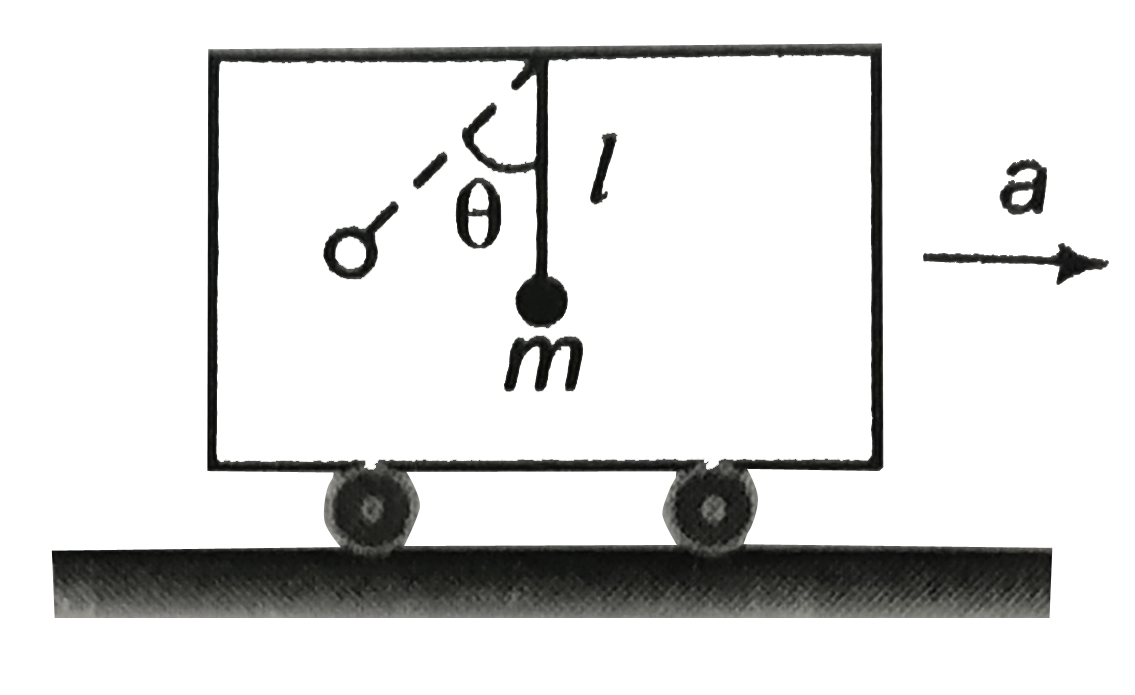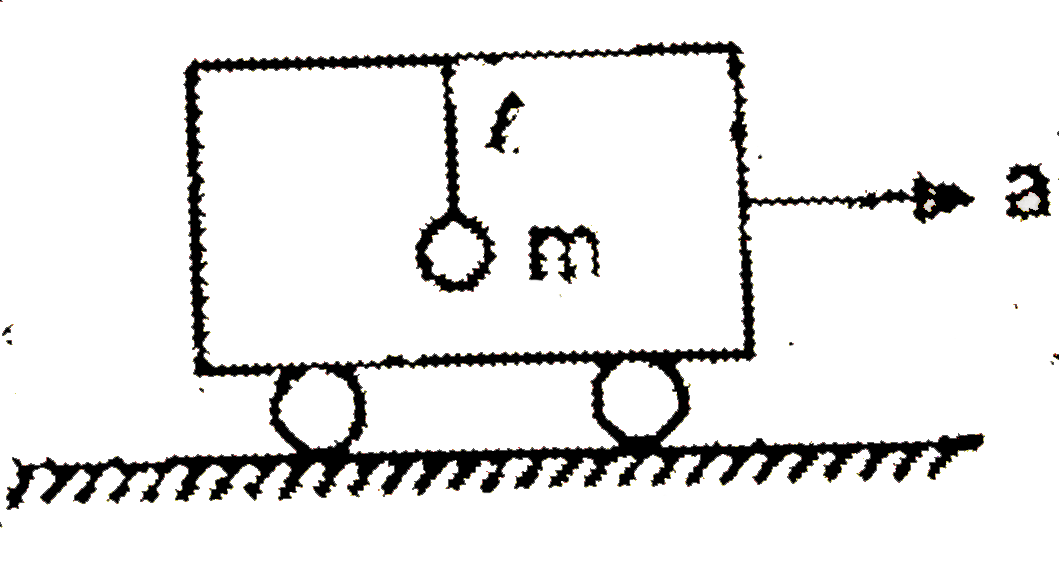When the trolley show in figure is given a horizontal acceleration a, the pendulem bob of mass m gets deflected to a maximum deflection , the net acceleration of the bob with respect to trolley is

√g2+a2
acosθ
gsinθ−acosθ
asinθ
The correct Answer is:C
With respect to trolley means , assume trolley at rest and apply a pseudo force (=ma, towards left) on the bob

anet=mgsinθ−macosθm
=gsinθ−acosθ
Topper's Solved these Questions
- LAWS OF MOTIONBOOK - DC PANDEYCHAPTER - LAWS OF MOTIONEXERCISE - Objective Question
32 Videos
- LAWS OF MOTIONBOOK - DC PANDEYCHAPTER - LAWS OF MOTIONEXERCISE - Comprehension
9 Videos
- LAWS OF MOTIONBOOK - DC PANDEYCHAPTER - LAWS OF MOTIONEXERCISE - Exercise 8.5
2 Videos
- KINEMATICS 1BOOK - DC PANDEYCHAPTER - KINEMATICS 1EXERCISE - INTEGER_TYPE
15 Videos
- LAWS OF THERMODYNAMICSBOOK - DC PANDEYCHAPTER - LAWS OF THERMODYNAMICSEXERCISE - Level 2 Subjective
18 Videos
Similar Questions
A spring block system is kept inside the smooth surface of a trolley as shown in finger.

At t=0 trolley is given an acceleration 'a' in the direction shown in figure. Write S−t equation of the block
(a) with respect to trolley.
(b) with respect to ground.
View SolutionIf trolley accelerates horizontally with acceleration a then bob is displaced backward from its initial vertical position. The angular deflection of the bob in equilibrium is

View Solution
Knowledge Check
The ring shown in fig. is given a constant horizontal acceleration (a0=g√3). The maximum deflection of the string from the vertical is θ0. Then
 Aθ0=30∘Bθ0=60∘CAt maximum deflection, tension in string is equal to mg.DAt maximum deflection, tension in string is equal to 2mg√3
Aθ0=30∘Bθ0=60∘CAt maximum deflection, tension in string is equal to mg.DAt maximum deflection, tension in string is equal to 2mg√3A simple pendulum with a bob of mass m is suspended from the roof of a car moving with horizontal acceleration a
AThe string makes an angle of tan−1(a/g) with the verticalBThe string makes an angle of sin−1(ag) with the verticalCThe tension in the string is m√a2+g2DThe tension in the string is m√g2−a2A trolley of mass M is attached to a block of mass m by a string passing over a frictionless pulley as shown in the figure. If the coefficient of friction between the horizontal surface and wheels of trolley is μ, then acceleration of the block m and that of trolley M on releasing the system is :-
 A(μM−mm+μM)gB(m+μMμM−m)gC(μm−Mm+M)gD(m−μMm+M)g
A(μM−mm+μM)gB(m+μMμM−m)gC(μm−Mm+M)gD(m−μMm+M)g
The acceleration a of trolley so that block of mass m remains stationary with respect to rough trolley as shown in the figure, is m Trolley 0 - ...
View SolutionA simple pendulum with a bob of mass m is suspended from the roof of a car moving with a horizontal acceleration a.
View SolutionIn shown figure, the trolley starts accelerating with acceleration a. The maximum angle deflected by thread from vertical will be:

View SolutionA bob of mass m=50g is suspended form the ceiling of a trolley by a light inextensible string. If the trolley accelerates horizontally, the string makes an angle tˆa=37∘ with the vertical. Find the acceleration of the trolley.

View SolutionA ball of mass m=1kg is hung vertically by a thread of length 1=1.50m. Upper end of the thread is attached to the ceiling of a trolley of mass M=4kg. Initially, the trolley is stationary and it is free to move along horizontal rails with out friction. A shell of mass m=1kg, moving horizontally with velocity v0=6m/s collides with thread starts to deflect towards right

At the time a maximum deflection of the thread with vertical, the trolley will move with velocity
View Solution
